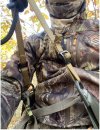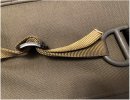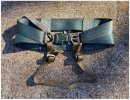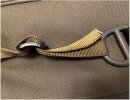- Joined
- Jan 3, 2022
- Messages
- 4,274
I built a Wraptor 2 panel saddle a year or so back and I really like it. I have the bridge made from tubular webbing. It is routed through some heavy duty steel "triglides?" I bought from Eastern Woods. I think they are 4000 pound rated. I have the tag ends doubled over and sewed so they won't back out and I also sewed the web below the tag end to the bridge itself. There is the question that has been nagging at me a little lately.
Am I correct in saying that sewing webbing weakens it? I believe that is true. My concern, and it may be unfounded, is that the sewing through the actual bridge going to be an issue or not? Would it be better to route it back through the triglide like shown in the second picture and then sew the tag back onto itself so it can't back out. That way no actual weight bearing webbing is sewn through.
Thoughts?
Am I correct in saying that sewing webbing weakens it? I believe that is true. My concern, and it may be unfounded, is that the sewing through the actual bridge going to be an issue or not? Would it be better to route it back through the triglide like shown in the second picture and then sew the tag back onto itself so it can't back out. That way no actual weight bearing webbing is sewn through.
Thoughts?





